St.LOUIS sailed in May 1939 with Jewish refugees to Cuba, a voyage known today as the VOAYAGE of the DAMNED.
On May 13, 1939, the German liner St.LOUIS
sailed from Hamburg, Germany, for Havana, Cuba. On the voyage were 937
passengers. Almost all were Jews fleeing from the Third Reich. Most were
German citizens, some were from eastern Europe, and a few were
officially "stateless".
Basicly the journey was a fraud, set up by sinister Propaganda Minister Josef Goebbels and his staff, to showcase nobody is interested in wanting Jews among them ... and till a seeming bitter end the free countries played in the Nazis directed game as they wished ...
by Earl of Cruise
based on Holocaust Ecyclopedia´s article
St.LOUIS, sister ship of MILWAUKEE, were motorships of HAMBURG AMERIKA LINIE which served on different lines for HAPAG, as well on cruises - collection Earl of Cruise
The majority of the Jewish passengers had applied for Cuba tourist visas and US immigration visas. They
had planned staying in Cuba only until they could enter the United
States. But by the time the St.LOUIS sailed, there were signs that political conditions in Cuba
might keep the passengers from landing there. The US State Department
in Washington, the US consulate in Havana, some Jewish organizations,
and refugee agencies were all aware of the situation. The passengers
themselves were not informed; most were compelled to return to Europe.
St.LOUIS was commanded by captain Gustav Schröder, who was a non-Jewish German who insisted to great lengths to ensure dignified treatment for his passengers.
The journey to Cuba was a joyous affair. The passengers aboard St.LOUIS had suffered ill-treatment in Germany, but on board, they were
treated very well, at the insistence of Captain Schröder.
Food served included items subject to rationing in Germany, and
childcare was available while parents dined. Dances and concerts were
put on, and on Friday evenings, religious services were held in the
dining room, even though he knew this would be
viewed unfavorably by the then ruling Nazi Party. A bust of Hitler was covered by a tablecloth. Swimming
lessons took place in the on-deck pool. Lothar Molton, a boy traveling
with his parents, said that the passengers thought of it as "a vacation
cruise to freedom".
Jewish passengers of St.LOUIS boarding in May 1939 in hope of escape - Source: Wikipedia
Jewish passengers of St.Louis boarding in May 1939 - Source: Heimatlos auf hoher See
Jewish refugees boarding St.LOUIS - source: Spiegel Trump und die Erinnerung an die Irrfahrt der St.LOUIS
Since the Reichskristallnacht (German: [ˌʁaɪçs.kʁɪsˈtalnaχt] ( listen))
(literally the "Night of Crystal", also known international as the "Night of
Broken Glass") pogrom of November 9th - 10th, 1938, the German government had
sought to accelerate the pace of forced Jewish emigration. The German
Foreign Office and the Propaganda Ministry in first place hoped to exploit the unwillingness of other nations to admit large
numbers of Jewish refugees to justify the Nazi regime's anti-Jewish
goals and policies both domestically in Germany and in the world at
large.
listen))
(literally the "Night of Crystal", also known international as the "Night of
Broken Glass") pogrom of November 9th - 10th, 1938, the German government had
sought to accelerate the pace of forced Jewish emigration. The German
Foreign Office and the Propaganda Ministry in first place hoped to exploit the unwillingness of other nations to admit large
numbers of Jewish refugees to justify the Nazi regime's anti-Jewish
goals and policies both domestically in Germany and in the world at
large.
The owners of St.LOUIS, the HAMBURG AMERIKA LINIE, knew
even before the ship sailed that its passengers might have trouble
disembarking in Cuba. The passengers, who held landing certificates and
transit visas issued by the Cuban Director-General of Immigration, did
not know that Cuban President Federico Laredo Bru had issued a decree
just a week before the ship sailed that invalidated all recently issued
landing certificates. Entry to Cuba required written authorization from
the Cuban Secretaries of State and Labor and the posting of a $500 bond
(The bond was waived for US tourists).
The voyage of St.LOUIS attracted a great deal of media
attention. Even before the ship sailed from Hamburg, right-wing Cuban
newspapers deplored its impending arrival and demanded that the Cuban
government cease admitting Jewish refugees. Indeed, the passengers
became victims of bitter infighting within the Cuban government. The
Director-General of the Cuban immigration office, Manuel Benitez
Gonzalez, had come under a great deal of public scrutiny for the illegal
sale of landing certificates. He routinely sold such documents for $150
or more and, according to US estimates, had amassed a personal fortune
of $500,000 to $1,000,000. Though he was a protégé of Cuban army chief
of staff (and future president) Fulgencio Batista, Benitez's
self-enrichment through corruption had fueled sufficient resentment in
the Cuban government to bring about his resignation.
St.LOUIS was not even allowed to embark in Havana, here anchoring off Malecón - collection Earl of Cruise
More than money, corruption, and internal power struggles were at
work in Cuba. Like the United States and the Americas in general, Cuba
struggled with the Great Depression. Many Cubans resented the relatively
large number of refugees (including 2,500 Jews), whom the government
had already admitted into the country, because they appeared to be
competitors for scarce jobs.
Hostility toward immigrants fueled both antisemitism and xenophobia. Both agents of Nazi Germany and indigenous right-wing movements hyped the immigrant issue in their publications and demonstrations, claiming that incoming Jews were Communists. Two of the papers - Diario de la Marina, owned by the influential Rivero family, and Avance, owned by the Zayas family, had supported the Spanish fascist leader General Francisco Franco, who, after a three-year civil war, had just overthrown the Spanish Republic in the spring of 1939 with the help of Nazi Germany and Fascist Italy. Reports about the impending voyage fueled a large antisemitic demonstration in Havana on May 8, five days before St.LOUIS sailed from Hamburg. The rally, the largest antisemitic demonstration in Cuban history, had been sponsored by Grau San Martin, a former Cuban president. Grau spokesman Primitivo Rodriguez urged Cubans to "fight the Jews until the last one is driven out." The demonstration drew 40,000 spectators. Thousands more listened on the radio
Hostility toward immigrants fueled both antisemitism and xenophobia. Both agents of Nazi Germany and indigenous right-wing movements hyped the immigrant issue in their publications and demonstrations, claiming that incoming Jews were Communists. Two of the papers - Diario de la Marina, owned by the influential Rivero family, and Avance, owned by the Zayas family, had supported the Spanish fascist leader General Francisco Franco, who, after a three-year civil war, had just overthrown the Spanish Republic in the spring of 1939 with the help of Nazi Germany and Fascist Italy. Reports about the impending voyage fueled a large antisemitic demonstration in Havana on May 8, five days before St.LOUIS sailed from Hamburg. The rally, the largest antisemitic demonstration in Cuban history, had been sponsored by Grau San Martin, a former Cuban president. Grau spokesman Primitivo Rodriguez urged Cubans to "fight the Jews until the last one is driven out." The demonstration drew 40,000 spectators. Thousands more listened on the radio
Course of St.Louis - collection Earl of Cruise
When St.LOUIS arrived in Havana harbor on May 27, the
Cuban government admitted 28 passengers: 22 of them were Jewish and had
valid US visas; the remaining six - four Spanish citizens and two Cuban
nationals - had valid entry documents. One further passenger, after
attempting to commit suicide, was evacuated to a hospital in Havana. The
remaining 908 passengers (one passenger had died of natural causes en
route) - including one non-refugee, a Hungarian Jewish businessman - had
been awaiting entry visas and carried only Cuban transit visas issued by
Gonzalez. 743 had been waiting to receive US visas. The Cuban
government refused to admit them or to allow them to disembark from the
ship.
In the 1976 drama film about the St. Louis, Voyage of the Damned, Schröder is played by Swedish-French actor Max von Sydow. - Source: YouTube
The events of the voyage are told in the 1974 book Voyage of the Damned, written by Gordon Thomas and Max Morgan-Witts, which was the basis of a 1976 film drama of the same name.
After Cuba denied entry to the passengers on St.LOUIS,
the press throughout Europe and the Americas, including the United
States, brought the story to millions of readers throughout the world.
Though US newspapers generally portrayed the plight of the passengers
with great sympathy, only a few journalists and editors suggested that
the refugees be admitted into the United States.
On May 28, the day after St.LOUIS docked in Havana, Lawrence Berenson, an attorney representing the US-based Jewish Joint Distribution Committee (JDC), arrived in Cuba to negotiate on behalf of St.LOUIS
passengers. A former president of the Cuban-American Chamber of
Commerce, Berenson had had extensive business experience in Cuba. He met
with President Bru, but failed to persuade him to admit the passengers
into Cuba. On June 2, Bru ordered the ship out of Cuban waters.
Nevertheless, the negotiations continued, as St.LOUIS sailed
slowly toward Miami. Bru offered to admit the passengers if the JDC
posted a $453,500 bond ($500 per passenger). Berenson made a
counteroffer, but Bru rejected the proposal and broke off negotiations.
The Doomed voyage of St.LOUIS Documentary, history Chanel - Source: YouTube
Sailing so close to Florida that they could see the lights of Miami, some passengers on St.LOUIS
cabled President Franklin D. Roosevelt asking for refuge. Roosevelt
never responded. The State Department and the White House had decided
not to take extraordinary measures to permit the refugees to enter the
United States. A State Department telegram sent to a passenger stated
that the passengers must "await their turns on the waiting list and
qualify for and obtain immigration visas before they may be admissible
into the United States." US diplomats in Havana intervened once more
with the Cuban government to admit the passengers on a "humanitarian"
basis, but without success.
Quotas established in the US Immigration and Nationality Act of 1924 strictly limited the number of immigrants
who could be admitted to the United States each year. In 1939, the
annual combined German-Austrian immigration quota was 27,370 and was
quickly filled. In fact, there was a waiting list of at least several
years. US officials could only have granted visas to St.LOUIS
passengers by denying them to the thousands of German Jews placed
further up on the waiting list. Public opinion in the United States,
although ostensibly sympathetic to the plight of refugees and critical
of Hitler's policies, continued to favor immigration restrictions!
The
Great Depression had left millions of people in the United States
unemployed (1939 - 12,000,000) and fearful of competition for the scarce few jobs available.
It also fueled antisemitism, xenophobia, nativism, and isolationism. A Fortune Magazine
poll at the time indicated that 83 percent of Americans opposed
relaxing restrictions on immigration. President Roosevelt could have
issued an executive order to admit St.LOUIS refugees, but
this general hostility to immigrants, the gains of isolationist
Republicans in the Congressional elections of 1938, and Roosevelt's
consideration of running for an unprecedented third term as president
were among the political considerations that militated against taking
this extraordinary step in an unpopular cause.
Roosevelt was not alone in his reluctance to challenge the mood of the nation on the immigration issue. Three months before St.LOUIS
sailed, Congressional leaders in both US houses allowed to die in
committee a bill sponsored by Senator Robert Wagner (D-N.Y.) and
Representative Edith Rogers (R-Mass.). This bill would have admitted
20,000 Jewish children from Germany above the existing quota.
Two smaller ships carrying Jewish refugees sailed to Cuba in May 1939. The French ship, the FLANDRE, carried 104 passengers; ORDUŇA, a British vessel, held 72 passengers. Like St.LOUIS, these ships were not permitted to dock in Cuba. FLANDRE turned back to its point of departure in France, while ORDUŇA
proceeded to a series of Latin American ports. Its passengers finally
disembarked in the US-controlled Canal Zone in Panama. The United States
eventually admitted most of them.
Captain among his "Damend passengers" - collection Earl of Cruise
Following the US government's refusal to permit the passengers to disembark, St.LOUIS finally sailed back to Europe
on June 6, 1939. The passengers did not return to Germany, however.
Jewish organizations (particularly the Jewish Joint Distribution
Committee) negotiated with four European governments to secure entry
visas for the passengers: Great Britain took 288 passengers; the
Netherlands admitted 181 passengers, Belgium took in 214 passengers; and
224 passengers found at least temporary refuge in France. Of the 288
passengers admitted by Great Britain, all survived World War II save
one, who was killed during an air raid in 1940. Of the 620 passengers
who returned to continent, 87 (14%) managed to emigrate before the
German invasion of Western Europe in May 1940. 532 St.LOUIS
passengers were trapped when Germany conquered Western Europe. Just over
half, 278 survived the Holocaust. 254 died: 84 who had been in Belgium;
84 who had found refuge in Holland, and 86 who had been admitted to
France.
Captain Gustav Schroeder of St.Louis, negotiating in Antwerp - Source: Wikipedia
Gustav Schröder still in command of St.LOUIS, he prepared August 1939 for another
transatlantic voyage, but his passengers were not allowed to board. En
route, war was declared on Nazi Germany by both Britain and France.
Returning from Bermuda, Schröder evaded a Royal Navy blockade and docked at then neutral Murmansk.
With a minimum crew aboard, he managed to slip past Allied patrols and
reached Hamburg on New Year's Day of 1940. He was assigned a desk job
and never again went to sea. After the war, he worked as a writer and
tried to sell his story. He was released from de-Nazification proceedings on the testimony of some of his surviving Jewish refugee passengers.
Gustav Schröder received much praise for his actions during the Holocaust, both while he was alive and posthumously. In 1957, he was awarded the Order of Merit by the Federal German Republic "for services to the people and the land in the rescue of refugees". In March 1993, Yad Vashem honored Schröder with the title of "Righteous Among the Nations" by the State of Israel. In 2000, the German city of Hamburg named a street after Schröder and unveiled a detailed plaque at the landing stages.
Gustav Schröder died in 1959 at the age of 73.
Among those saved and surviving is Arno Motulsky (born 1923 in Fischhausen near Königsberg, East Prussia to Jewish parents,), a professor of medical genetics and genome sciences at the University of Washington. He is known as the "father of pharmacogenomics", based on his report in 1957 of negative drug responses in some patients depending on their genetics at critical enzymes. He fled Nazi Germany in 1939 aboard the St. Louis but was rejected by US officials. Motulsky returned to Europe, initially settling in Brussels, Belgium, where he witnessed the German attack in 1940 and was confined as an enemy alien (i.e. German citizen) by Belgian authorities. Deported to St. Cyprien and the Gurs internment camp in southern France Motulsky finally managed to flee via Lisbon to the United States, where he arrived in 1941. He attended Yale University as part of the U.S. Army accelerated program and earned his M.D from University of Illinois, Chicago and did his residency with Karl Singer at the Michael Reese Hospital
in Chicago where he did hematology research. In 1953, he joined the
faculty of the University of Washington, where he established the Division of Medical Genetics in 1957
St.LOUIS was adapted as a German naval accommodation ship from 1940 to 1944. She was heavily damaged by the Allied bombings at Kiel on August 30, 1944, but was repaired and used as a hotel ship in Hamburg in 1946. She was later sold and was scrapped in 1952.
further readings
Gustav Schröder: Heimatlos auf hoher See. 1949
Gordon Thomas
und MaxMorgan-Witts: Das Schiff der Verdammten. Die Irrfahrt der St.
Louis (Originaltitel: Voyage of the Damned). Deutsch von Helmut Kossodo. Edition Bergh und
WMP-Verlagsauslieferungsdienst, Tübingen und Zug (Schweiz) 1976, 382 S., ISBN 3-88065-044-6.
Diane Afoumado: Exil impossible. L'errance des
Juifs du paquebot St. Louis, Paris, L'Harmattan, 2005, 286 S.; Vorwort von Serge Klarsfeld. (frz.)
Julian Barnes: Eine
Geschichte der Welt in 10 1/2 Kapiteln, deutsch 1990, ISBN 3-499-22134-9.
Georg Reinfelder, MS "St. Louis". Die
Irrfahrt nach Kuba Frühjahr 1939. Kapitän Gustav Schroeder rettet 906 deutsche
Juden vor dem Zugriff der Nazis. Hentrich & Hentrich Verlag, Berlin
2002, ISBN 3-933471-30-3.
Gilbert Sinoué: Un bateau pour l'enfer.
2005 (frz.)
Sarah A. Ogilvie und Scott Miller: Refuge Denied: The St. Louis Passengers and the Holocaust,
2006. ISBN 978-0-299-21980-2.
Art Spiegelman, St.
Louis-Flüchtlingsschiff-Blues, in: Die Zeit vom 27. August 2009, S. 47.
Georg Mautner Markhof:
Das St. Louis-Drama. Hintergrund und Rätsel einer mysteriösen Aktion des
Dritten Reiches. Leopold Stocker Verlag, Graz – Stuttgart 2001, ISBN 3-7020-0931-0.
Leonardo Padura: Ketzer,
Unionsverlag, Zürich 2014, ISBN 978-3-293-00469-6.
St.Louis Memorial Plate at St.Pauli-Landungsbrücken Brücke 3 (Hamburg-St.Pauli) - Source: Wikipedia
For each German citizen is essential to know the past, as it is an essential part of the modern day German democracy, to remind about and to never fall back into the darkest part of German history. We face it!

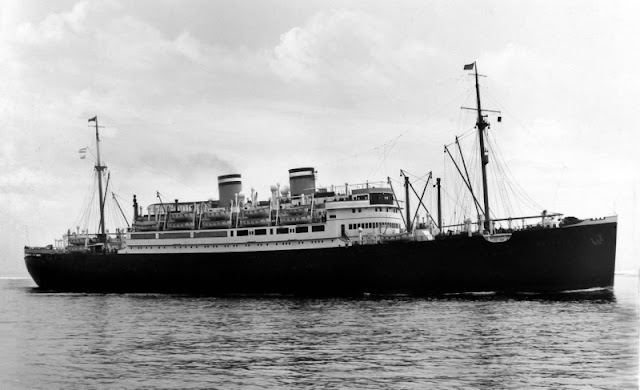
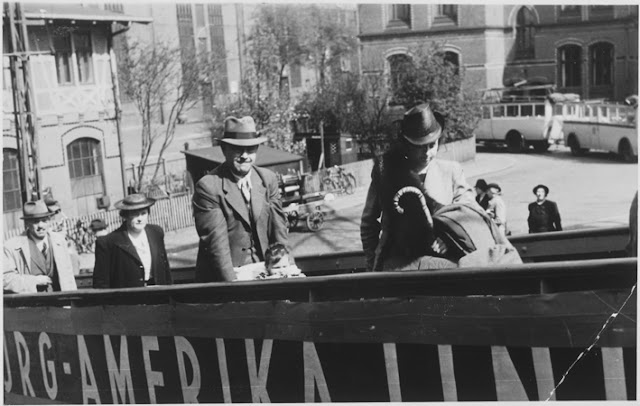
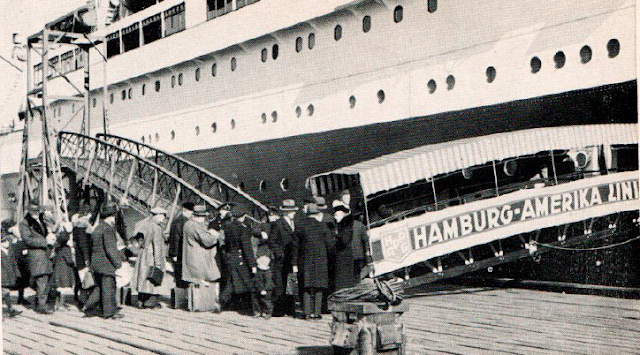
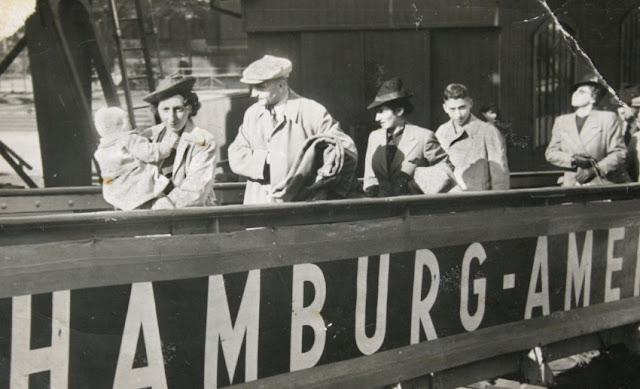
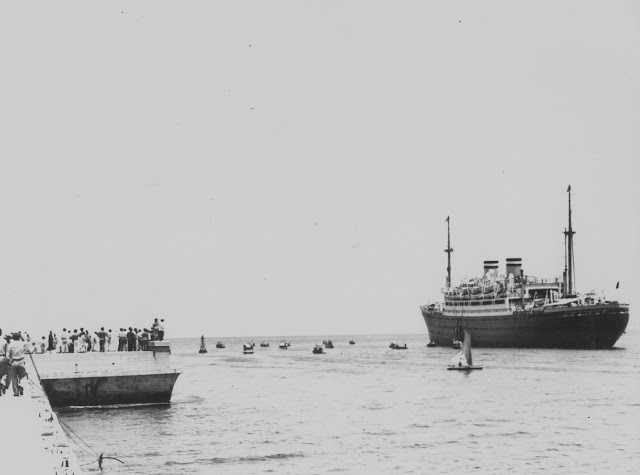


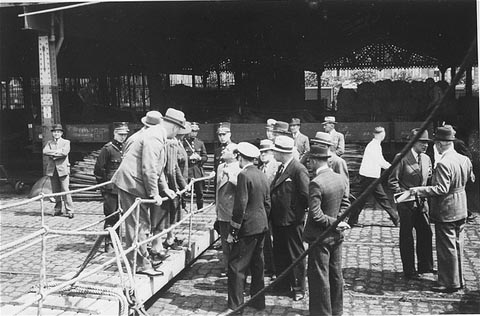


Comments
Post a Comment